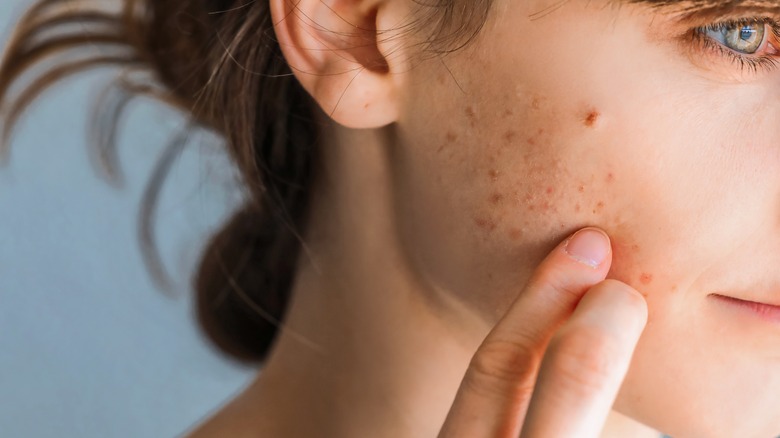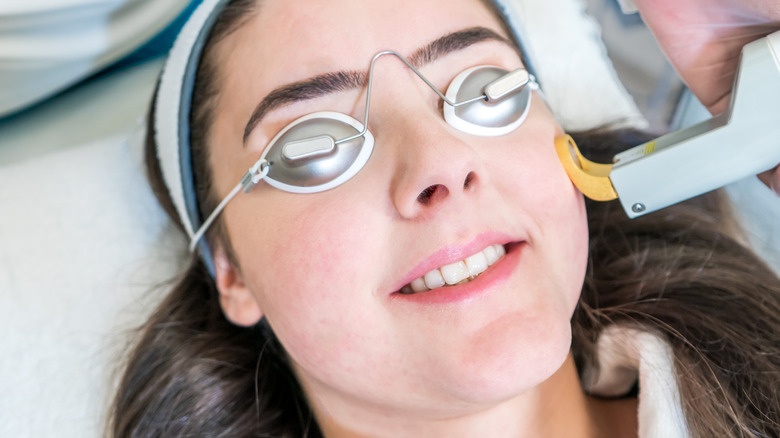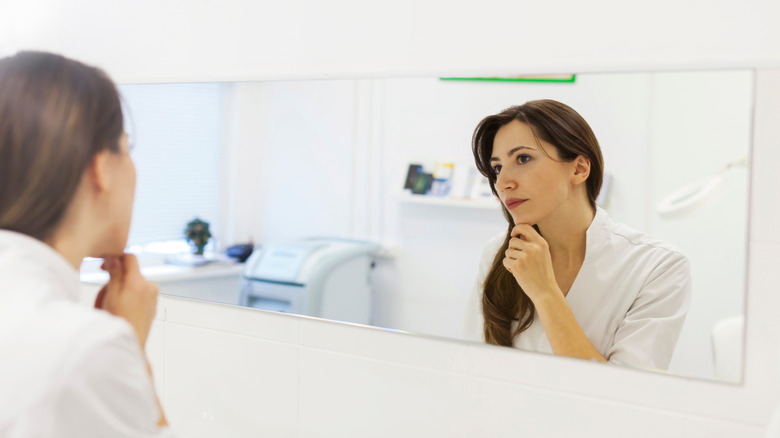What To Expect When You Get Laser Treatment For Acne Scarring
Acne comes and goes, but the scarring caused by the inflammatory process can take years and multiple treatments to remove. If you've had infected pimples or severe breakouts that were not properly treated, you're likely to have visible acne scars that vary in size and texture. According to DermNet, the most common types of acne scars include ice-pick scars, rolling scars, boxcar scars, atrophic scars, and keloid scars. Ice-pick scars sit deep below the surface of the skin and have a sunken appearance. Boxcar scars are shallow and have defined edges, whereas rolling scars have sloped edges. Atrophic scars appear as dents on the skin's surface, whereas keloid scars appear as larger, skin-colored lumps. Whatever type of scars you have, they all give your skin a pitted, textured appearance that could undermine your self-confidence.
Unfortunately, most acne scars don't fade by themselves or with topical treatments. Most of the time, more advanced treatments are needed to diminish the appearance of scarring. Soft tissue fillers, steroid injections, skin needling, and laser resurfacing are some go-to cosmetic procedures for treating acne scarring, according to dermatologist Lawrence E. Gibson via Mayo Clinic. So far, laser resurfacing is among the most dermatologist-recommended treatments for treating mild to deep acne scars. If you're eyeing laser treatment for acne scarring, here's what you should know about the procedure's benefits and drawbacks.
Laser treatment can diminish the appearance of acne scars
Generally speaking, laser treatments are considered the last word in treating the uneven coloration and depression in the skin brought on by acne scarring. "They are effective at breaking up scar tissue and inducing the formation of new collagen, which will soften the appearance of scars over time," explains dermatologist Dr. Dustin Portela (via Marie Claire). However, laser treatment cannot completely and permanently remove scars. It can only prevent the formation or reduce the appearance of scarring, alleviate any physical discomfort from scarring, and enhance your range of motion hitherto limited by scarring, the American Academy of Dermatology points out.
In short, if you have prominent acne scars, laser treatment can trade you less noticeable scars. Besides, the state of your scarring also plays a critical role in your treatment results. For instance, an uneven skin tone can be dealt with easily, while texture might take longer and multiple treatments. Most dermatologists recommend treating acne scars as early as possible as they get more pronounced with age due to a depletion of the skin's collagen. If your scars are old, they will take longer to see improvements, such as a more even complexion and unified canvas. If your scars are new, you can expect better results. Laser treatments may require anywhere from three to six treatments, or four weeks to months, to see noticeable improvements.
Before and after a laser treatment
During a consultation, your dermatologist will size up your skin conditions. For instance, if you have active acne, your clinician might ask you to wait until your condition clears up before putting you down for the procedure. At the same time, your dermatologist will also discuss the laser treatments that best suit your needs and wants. There are different kinds of lasers used for acne scarrings, such as IPL lasers, erbium YAG lasers, and carbon dioxide (CO2) lasers. Each targets a specific type of scarring that you have. Some dermatologists might recommend combining laser treatments with other facial therapies, such as vitamin C, facials, or microdermabrasion, to achieve optimal improvements.
Three to five days before your laser treatment, you'll need to stop using topical medication containing vitamin A derivatives, such as retinol, and exfoliants, such as AHAs, BHAs, and PHAs, per Illumia Medical. The reason being is these active ingredients might increase the risk of irritation to your skin and interfere with your healing process. Since smoking can curb blood circulation, you might need to discontinue smoking in about a week leading to your treatment, Dundee Dermatology points out. The downtime for a laser treatment depends on your conditions, lasting anywhere between two days to two weeks. Treated skin may have an itchy sensation and develop white bumps, but they will go away. After treatment, drink lots of water to keep your skin hydrated and wear sunscreen religiously to prevent scar darkening.


